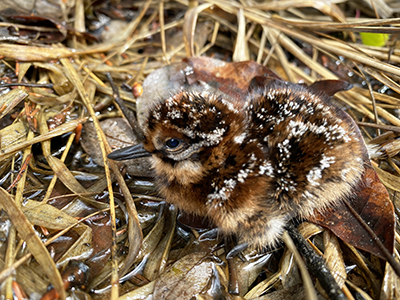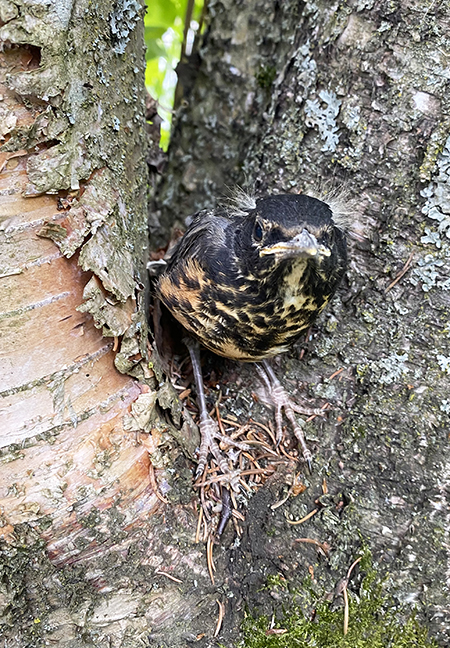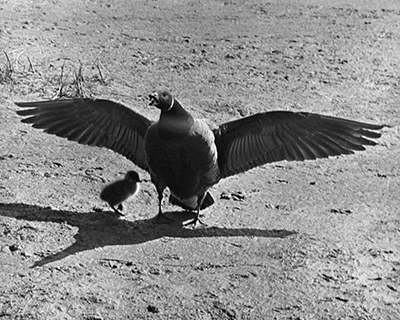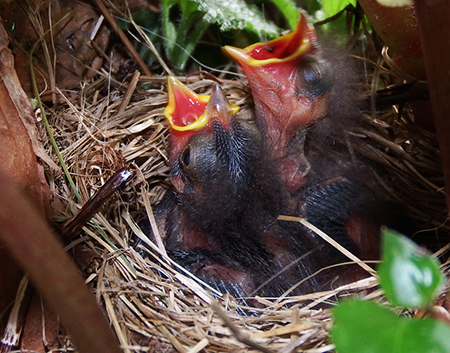Alaska Fish & Wildlife News
July 2022
I found a baby bird!

The baby robin ran away from me as I approached. It was surprisingly mobile despite its obvious youth, a bright yellow beak for begging for food, scraggly adult feathers growing in alongside its baby down, and scrawny wings that didn’t look much good for anything yet.
I was barely out of high school and was following a little bird that obviously could not fly, running across the ground and looking like an easy target for a stray cat. Wanting to protect the baby bird who I thought had perhaps fallen out of a nest, I safely captured it and brought it to a wildlife rehabilitator. The little bird was fed for a few days and eventually released back into the wild when it could fly.
While I meant well when I was 17, in hindsight, I should have left the baby bird where it was.
Unbeknownst to me, the robin was a fledgling who had jumped out of its nest on purpose and was safely roaming the ground and learning to fly while its parents were close by, ready to offer food when needed. This is an important part of a baby bird’s development and while it may look like the bird is in distress, often, they are simply learning. Capturing them can cause undue stress to both the baby bird and the parent whose chick just went missing.
There’s a baby bird in my yard! Now what?

If you find a baby bird on the ground, there are some clues you can look for to direct your next move for the best possible outcome.
Is the bird able to move on its own? Does it have any feathers at all? Even scraggly looking ones? If so, then it is a fledgling that is learning to fly. Its parents are likely nearby, and it should be left alone. Only move the fledgling if it is somewhere dangerous, such as a road, or near a cat or dog. Put the fledgling in a bush or on a branch to keep it out of harm’s way if needed.
If the baby bird has no feathers however, then it is a nestling and too young to be out on its own. If you can see or find an intact nest anywhere then you can put the nestling back into the nest and wait to see if the parents attend to it or are nearby. It is alright to touch a baby bird briefly. Its parents will not abandon it and will continue to care for the nestling if it is back in the nest.
If the baby bird looks injured, has been attacked, or you cannot find the nestling’s nest or parents, then it needs your help and you can call the Bird Treatment and Learning Center, based in Anchorage, at 907-562-4852 for further guidance. There, you can be directed to local resources if you are outside Anchorage, or receive more specific guidance based on your location and the bird’s situation.

It is understandable to want to help wildlife that seems to be in trouble, but it’s generally best to leave wild animals alone. Being handled by humans is stressful to the young and the parents and can be very detrimental to some species, especially with regard to thermoregulation and overheating. It is very common for birds and mammals to leave their young alone for short periods – or to be nearby and out of your sight – and it is very unlikely that the young are orphaned or abandoned.
You should never approach wildlife in most situations. Some animals carry diseases that affect people and pets. Animals and birds may become fiercely defensive and dangerous if they feel threatened or have infants or food to protect. Animals don’t know that you may mean them no harm and even close contact can frighten them.
Other ways to help your local baby birds
As baby bird season moves forward in Alaska, there are several other actions that can give the next generation of birds their best chance.
Watch the roads as you drive, especially near wetland areas as ducklings or other baby waterfowl might be alongside the street or even crossing the road.

Try to keep your cat indoors. Outdoor cats are deadly to young birds learning to fly. Domestic cats kill billions of birds and small mammals nationally every year. Cat owners are familiar with the frequent gifts of dead birds and small mammals left on the door mat – especially in summer when young animals are most vulnerable. And there are many more killed and injured that people never see. Indoor cats live longer; an indoor cat won’t get hit by a car, pick up ticks or other parasites, and will be safe from the diseases cats transmit to each other.
Keep a respectful distance from baby birds and their parents.
Baby birds are ubiquitous in the Alaska summertime! Goslings and cygnets paddle through the wetlands and awkward looking crane and shorebird chicks scuttle dorkily through the grass on their way to wetlands. Baby American Robins sport ridiculous looking wisp feathers as they scuttle across the ground and learn to fly under the care of their parents. All these little birds are the next generation of Alaska’s some 500 species of bird, and all deserve the respect and space to learn to be birds and fill their role in their respective ecosystem.
Subscribe to be notified about new issues
Receive a monthly notice about new issues and articles.
